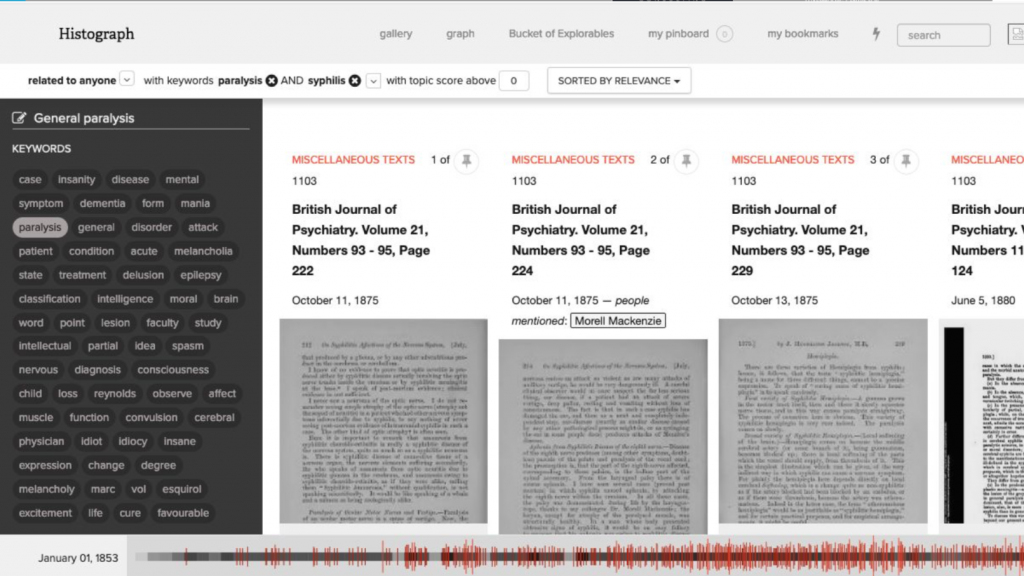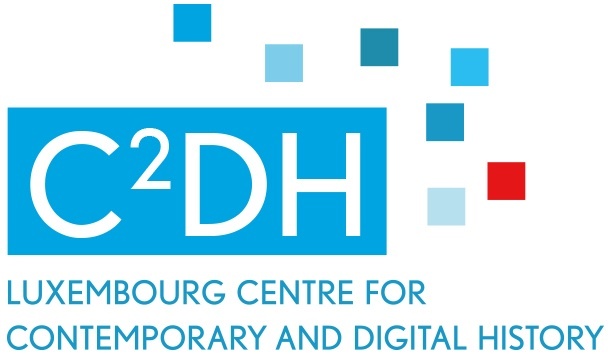The launch of the Doctoral Training Unit in Digital History and Hermeneutics (DTU-DHH) coincided with my joining a new research centre, the Centre for Contemporary and Digital History (C2DH), created in 2016. The centre adopted an increasingly digital approach, and so the DTU-DHH gave me tangible experience of the paths that digital history was taking, allowing me to become more familiar with the methodologies, challenges and tools of a field that is still in its early days.1
Digital history of psychiatry: uncharted territories
Eva Andersen, with whom I have worked closely over the past four years, specialises in transnational knowledge networks in psychiatry, primarily in the second part of the 19th century. Her Master’s dissertation focused on the Société de Médecine Mentale de Belgique. Like me, Eva Andersen was a “normal” historian with no particular training in digital history but she went through an extensive digital immersion thanks to a comprehensive programme of workshops, hands-on sessions, lectures and other activities as part of the DTU training programme. Her sources included a few manuscript collections but were essentially made up of large corpora of psychiatric journals, partly digitised, with more or less precise levels of text recognition. This very specific configuration shaped both her learning curve and also mine.

In practical terms, I had to get to grips with techniques such as the challenges of text recognition of large corpora, cleaning data to make it “readable” for computer programs, developing (and understanding) network visualisation, and text mining. My contact with digital humanities took place almost entirely through discussions with Eva Andersen, who served as a “digital history broker” for me. In this sense, our interaction was another example of the “inverted classroom”, where the teacher becomes a student and the student a teacher. My use of nodegoat in another project is directly linked to the discussions about this tool over the four years of Eva Andersen’s PhD.
The use of such large data sets is quite unusual in the history of psychiatry. The quantitative approach of social history has never really established a strong foothold within this subfield of the history of medicine. Over the past twenty years, cultural history and microhistory have been the dominant methods: historians of psychiatry can be characterised as mainly close readers, focusing for example on seminal scientific texts or (limited numbers of) patient files. Only recently has the history of the science of the mind begun to include digital methods to manage larger corpora of texts, for example as a way of depicting networks over time or changes in diagnostic categories. 2
Liminal trading zone
From my point of view, I was in what might be referred to as a liminal, second trading zone, while Eva Andersen and the other PhD students in the DTU formed a first trading zone with a far higher degree of hybridity. My presence on the fringes may also explain why there was no co-construction of a new common language, as my interaction was essentially limited to dialogue with Eva Andersen, who is from the same disciplinary field as me.
My contact with the other members of the DTU was minimal: I had limited contact with other PhD students because we share the same offices, but virtually no contact with the other professors involved in the project, apart from events explicitly planned for sharing ideas. This absence of “trading” seems to stem from a thematic organisation that continues to be structured around the (sub)disciplines involved; the theoretical framework – the hermeneutics of digital humanities – did not seem to be strong enough to bind the team. Shared time was rare. The absence of impromptu meetings, a result of the geographical dispersion of the team over the campus, also made the shared interdisciplinary digital history “factory” less tangible.
Making choices explicit
The centrality of digital hermeneutics in Eva Andersen’s PhD nevertheless led to a much more explicit articulation of methodological problems than with any other PhD student I have worked with so far. Making the methodological construct explicit by describing technical pathways in more detail (something that is not necessarily normal practice in contemporary history, unlike with other historical periods) and reporting failures – considered as an integral and visible part of the thesis – led to greater heuristic reflexivity.
Meanwhile, the PhD thesis remains firmly rooted in the historical disciplinary field. The Thesis Supervision Committee, composed of two historians and one computer scientist, was essentially a space for historiographical discussion. Eva Andersen presented her results to audiences composed of historians or a mixed audience, but never to audiences composed entirely of computer scientists. Computer science served at most as an auxiliary science.
Case studies instead of a theoretical framework
It seems to me – through what I observed in the work with Eva Andersen but also through my experience in other projects – that cooperation between humanities and computer science works best when it starts from very precise case studies that require a lot of shared time: it is the lack of possibilities for division of labour between humanities and computer science that makes cooperation productive.
Pairing supervisors and doctoral students from different disciplines could be a way of encouraging more cooperation, even though this option goes against the customs and habits of the academic world. The main challenge lies in the difficulty of finding common themes between humanities and computer science. What is central for historians has no “meaning” for computer science: historiographical knowledge (unless it relates to computer science itself) does not lead to the advancement of knowledge in computer science. On the other hand, knowledge in computer science for historians may seem to be merely an auxiliary science, but it is nevertheless considered as a necessary tool for the production of knowledge in the field of humanities. Potential interdisciplinarity is therefore strongly affected by this imbalance. The “necessity” that can be observed on one side does not exist on the other. While we can speak of digital humanities, there is no such thing as “social computer science”.
Edited by Juliane Tatarinov; English review by Sarah Cooper
Notes
- I started to follow this field in 2011 as a more or less enlightened amateur and embarked on a few experiments in digital humanities that remained short-lived: https://majerus.hypotheses.org/category/digital-humanities.
- Christopher D. Green, Ingo Feinerer and Jeremy T. Burman, “Searching for the structure of early American psychology: Networking Psychological Review, 1894-1908”, History of Psychology, 2015, vol. 18, no. 1, p. 15-31 or Virginia Berridge, Jennifer Walke and Alex Mold, “From Inebriety to Addiction: Terminology and Concepts in the UK, 1860-1930”, The Social History of Alcohol and Drugs, 2014, vol. 28, no. 1, p. 88-106.


